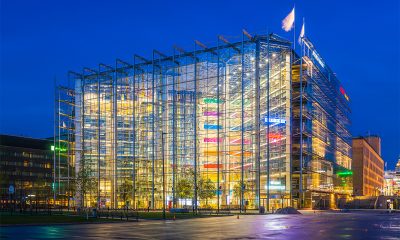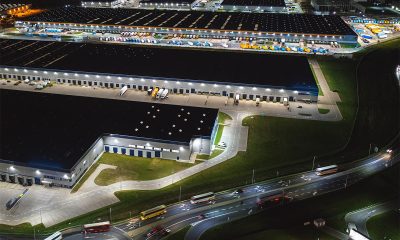What is a smart street light
Smart street lights are intelligent roadway and area lighting systems capable of leveraging data collected from sensors, local controllers, central management systems, personal devices (e.g., smartphones, tablets), or any combination of these, to implement adaptive lighting techniques and/or sophisticated control algorithms. The concept of the buzzword “smart lighting” is under constant evolution. It once meant adaptive lighting provided by light fixtures that can execute automatic lighting control strategies. It was about dimming or turning on and off the lights in response to sensors and timers, without physically touching a switch. Today’s smart street lighting has functionality that goes beyond adaptability enabled by standalone control solutions. It encompasses a number of concepts. At its most basic, a smart street light is connected and intelligent. It can come with different levels of context awareness, network connectivity and processing capability that allow automating lighting based on various prediction algorithms or providing active or passive responses to users.
LED technology brings lighting to a new level of sophistication
The dynamics within the smart lighting market are accelerated by the massive use of solid state lighting based on LED technology. LEDs are semiconductor devices that convert electrical power to light through the recombination of electronic carriers (electrons and holes) in the region of the diodes. Phosphor converted LEDs produce white light through partial or complete conversion of electroluminescence to electromagnetic radiation spanning a broad range of wavelengths in the visible region of the spectrum via photoluminescence in phosphors. The emission mechanism of LEDs not only yields a high quantum efficiency in producing white light, but also lends digital controllability to the light source.
Traditional light sources, which are primarily gas discharge lamps, suffer from poor dimmability and limited switching cycles. In contrast, LEDs allow for instantaneous control over the full range of intensity and can withstand high frequency on/off switching. These semiconductor devices work seamlessly with other solid state circuits, which affords luminaire designers the chance to build more controls into lighting systems and create a compelling value proposition for the user. The ability of LED systems to easily accommodate the integration of sensors, processors, and network interfaces sparked a digital transformation in lighting control and embarked on the next generation of smart street lighting which can be defined by three fundamental characteristics: controllability, adaptation and connected architectures.
Intelligence and connectivity
Rounding out the capabilities that solid state lighting can bring to street lighting applications is the creation of a digital ecosystem with virtually limitless integrations. A holistic framework which integrates LEDs, sensing, intelligence and networking into one system can be established to multiply the energy efficiency benefits of LED street lights beyond just improvements to light source efficiency.
Smart LED street light operate on a set of sensors which include motion sensors for controlling lights in areas with irregular usage patterns, dusk-to-dawn photocontrols (photocells) for daylight harvesting, and on-board sensors that provide measurable parameters on the condition of the LED luminaire and its power consumption. Building intelligence into LED luminaires provides embedded programmability that enables control and automation based on different variables provided by the sensors or according to user-defined software rules.
However, the potential of smart lighting can only be unlocked when street lights are able to communicate. While intelligent lighting systems can automatically manage some aspects of their operation for maximized efficiency and quality of lighting, such intelligence has to be pre-defined or pre-programmed locally on a single piece of equipment. The intelligent lighting solution will not be scalable, extensible and economical to deploy, upgrade and operate unless the equipment can communicate.
Network architecture
Smart lighting is also called connected lighting for the reason that the need for networking connection has become a basic design requirement. With a direct network connection to LED street lights complete control over lighting can be exercised with a centralized controller or controlling devices such as smart phones, smart watches, tablets, etc. Connecting street lights together in a computer-controlled network allows the operation of equipment to be coordinated across an entire installation, facilitates the retrieval of sensor information and exchanging information between nodes within a network, and enables time-sensitive operating instructions to be remotely commanded and other advanced features that substantially impact operating efficiency and cost to be executed.
A networked lighting control system operates a software platform, typically known as a central management system (CMS) which delivers a secure web-based interface on a desktop and mobile device. The CMS is hosted on a central computer which can be a cloud server or an on-premises server. It typically communicates with a gateway through a wired or wireless connection. A gateway is data coordinator that act as a link between the CMS and streetlight controllers. As a network interface device a gateway can translate between different protocols and relay communication between the CMS and streetlight controllers.
Communication protocols
The ability of a connected street lighting network to facilitate secure, efficient interoperation, collaboration and sharing of resources is built on its bidirectional networking capabilities. The networked control system may use a range of network communication technologies to forward information between street lights to a nearby gateway as well as connect the gateway to the CMS. Power line carrier (PLC) and Ethernet are the typical communication platforms for wired systems. Wireless devices typically communicate via the radio frequency spectrum. Long range RF communication solutions include NB-IoT, LTE-M, LoRa, Sigfox, Ingenu, etc. A proliferation of short range networking technologies are available to provide wireless connectivity between endpoints (street lights). Their topologies are designed either as star networks or mesh networks. A star network such as WiFi has a centralized configuration in which all peripheral nodes communicate with all others by transmitting to, and receiving from, the central node only. In mesh networking, nodes within a specified range are interconnected with others, so there are multiple paths connecting each node.
Wireless street lighting systems are often organized using mesh architecture because it imparts reliability, scalability and redundancy for the communications mission. Wireless mesh networks are self-healing. They support continuous connections and reconfiguration around broken or blocked paths, enabling a network to dynamically generate new routes and reconfigure itself in response to any failures. The mesh network can deliver distributed intelligence to create an easily scalable infrastructure. ZigBee, Z-Wave, Thread, and Bluetooth Mesh are commonly used short-range wireless mesh connections.
Internet of Things (IoT)
As street lighting systems become more connected and intelligent there comes a need for a network infrastructure that coordinates the handling of massive data flow, device management, secure connectivity, and the execution of other services and end-user applications. This need drives the trend towards the Internet of Things (IoT) which extends the Internet Protocol (IP) communication beyond its established computer and smartphone markets to resource-constrained endpoints.
The introduction of IoT as the backbone for street lighting systems establishes a seamless communication between lighting and the Internet, enables contextual services and data sharing between devices, and provides a framework for device management and service enablement. The ubiquity of street lighting provides the opportunity to create a network of digital nodes which cannot only enable improved lighting control but also open the door to a wide range of innovative capabilities, including traffic management, smart parking, environmental monitoring, electric vehicle (EV) charging, public safety and emergency services, crime detection and prevention, digital signage, and extended WiFi and cellular communications.
Core to the IoT architecture is the IoT platform that orchestrates the movement of data between heterogeneous IoT devices and IoT applications. An IoT platform is an array of software components that streamline data and device management within a defined infrastructure in association with communication protocols and security management.
Driver and control circuitry
The beating heart of a smart LED street light is the LED driver. The driver provides regulated output power to the LEDs and, equally importantly, communicates with its environment, interacts with software platforms and performs sophisticated lighting control. In the context of smart lighting applications, two important performance markers of an LED driver are its dimming capability and compatibility with controls. Constant current LED drivers support both pulse-width modulation (PWM) and constant-current reduction (CCR) dimming. They are configured to accept control input through a digital interface which can be digital addressable lighting interface (DALI), DMX, ZigBee, Z-Wave, etc. Incorporating intelligence and network connectivity into LED street lights may require the LED driver to carry a microcontroller-based or programmable architecture.



















Loading...